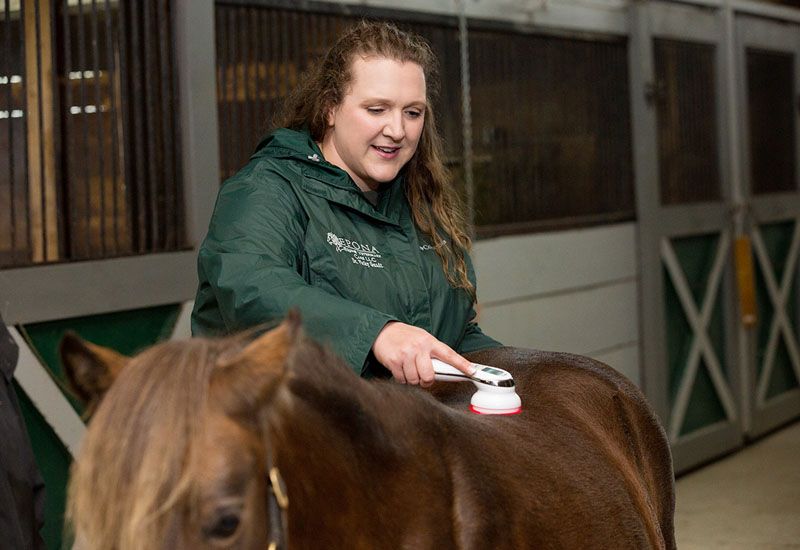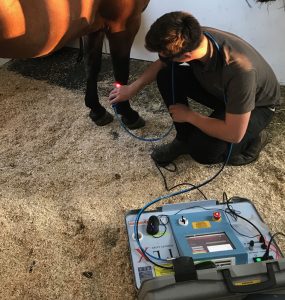Equine Therapy Success Stories: Real People, Real Psychological Transformations
Laser Treatment in Equine Therapy: A Modern Method to Improving Horse Wellness
Laser therapy has actually become a critical strategy in equine treatment, utilizing focused light energy to cultivate cellular repair and quicken healing from a selection of conditions. This non-invasive approach is specifically effective in taking care of musculoskeletal injuries, injuries, and inflammatory conditions, significantly boosting general steed health and wellness. By stimulating mitochondrial task and boosting ATP manufacturing, laser therapy not just improves blood circulation yet likewise provides significant pain alleviation. As this cutting-edge treatment proceeds to gain grip, it opens fascinating possibilities for resolving chronic problems like arthritis and unguis problems, signifying a transformative shift in vet care. What makes this method specifically compelling?
Understanding Laser Therapy
Laser therapy, a non-invasive treatment technique, has gotten substantial grip in equine medication as a result of its efficiency in advertising recovery and discomfort alleviation. This innovative therapeutic approach utilizes focused light energy to penetrate tissues, fostering cellular repair work and regeneration. The underlying mechanism involves the stimulation of cellular mitochondria, leading to increased production of adenosine triphosphate (ATP), the power currency of cells. Enhanced ATP levels quicken cells fixing procedures and minimize inflammation, making laser therapy specifically reliable for dealing with musculoskeletal injuries, wounds, and various other inflammatory problems in equines.
There are numerous kinds of lasers used in equine treatment, each with particular wavelengths and power results customized to different healing needs. Low-level laser treatment (LLLT), likewise referred to as cool laser therapy, uses lower power degrees to promote cell function without creating thermal damages. High-intensity laser therapy (HANDLE), on the other hand, makes use of higher power degrees to accomplish much deeper tissue penetration and more significant healing impacts.
Veterinarians make use of different laser tools and methods depending on the problem being treated and the wanted depth of cells penetration. Proper training and know-how are important for guaranteeing the secure and efficient application of laser treatment, thus optimizing its therapeutic capacity while decreasing dangers.
Advantages for Equine Wellness
With a solid understanding of how laser therapy functions, it is crucial to discover its various benefits for equine health. By boosting mobile feature, laser therapy promotes faster injury recovery and help in the regeneration of damaged cells.
Moreover, laser treatment has been shown to boost blood circulation, consequently enhancing blood flow to influenced locations. Improved circulation makes certain that crucial nutrients and oxygen are supplied much more efficiently, facilitating the recovery process. Additionally, laser treatment's anti-inflammatory impacts help in lowering swelling and pain, which is vital for additional info the general well-being of the steed.
Pain management is an additional considerable benefit. By launching endorphins and blocking pain signals, laser treatment provides reliable, non-invasive alleviation from both severe and chronic discomfort. This can contribute to improved flexibility and lifestyle for the pet.
Last but not least, laser treatment is a non-invasive treatment option, decreasing the threat of difficulties associated with more intrusive procedures. Its versatility and efficiency make it an invaluable device in contemporary equine veterinary medicine.
Typical Problems Dealt With

An additional widespread problem treated with laser therapy is arthritis. Additionally, laser treatment is used in the administration of wounds.
Equine respiratory system problems, such as reoccurring respiratory tract obstruction (RAO), also react favorably to laser treatment. Laser therapy is valuable in treating unguis issues, consisting of laminitis and abscesses.
Treatment and Safety
Implementing laser treatment in equine treatment entails a careful procedure to ensure both efficiency and security. Equine Therapy. The process begins with an extensive veterinary analysis to determine the suitability of laser treatment for the horse's details problem. Once regarded appropriate, the treatment location is prepared by cleaning and, if necessary, clipping the hair to boost laser infiltration
The specialist must pick the appropriate type of laser, typically a low-level laser (LLLT) or a high-power laser (HPL), relying on the condition being treated. The laser tool is then adjusted to the suitable wavelength, power, and duration settings. Throughout the application, the practitioner relocates the laser over the targeted area in a methodical fashion, guaranteeing regular and also exposure.
Security methods are strictly abided by, consisting of making use of safety eyewear for both the professional and the steed. Additionally, it is important to check the horse for any type of indicators of discomfort or negative responses throughout the click to investigate treatment. Post-treatment, the horse is typically offered a duration of remainder to allow the therapeutic effects to materialize.

Future of Horse Laser Treatment
As innovations in vet medicine continue to unravel, the future of equine laser therapy holds substantial guarantee. Arising innovations and much deeper scientific understandings are readied to refine and expand the applications of laser check my source therapy for steeds. One of one of the most anticipated developments is the integration of advanced imaging strategies that enable extra specific targeting of damaged tissues, thus enhancing therapeutic end results. Furthermore, the development of mobile and easy to use laser gadgets is most likely to make this therapy much more accessible to a more comprehensive variety of specialists and steed owners.
Moreover, continuous research right into the molecular and mobile systems of laser treatment will likely produce optimized procedures customized to particular problems, improving performance and decreasing therapy times. Personalized treatment plans based upon genetic and biochemical markers can come true, making sure that each steed gets one of the most appropriate and reliable treatment.
Additionally, governing developments and standardization of methods will improve the trustworthiness and dependability of laser treatment in equine method. Equine Therapy. As these innovations continue to arise, equine laser therapy is poised to come to be a vital component of veterinary treatment, offering enhanced recovery and improved high quality of life for horses around the world
Final Thought
